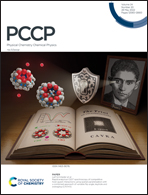Milliwatt three- and four-pulse double electron electron resonance for protein structure determination†
Abstract
Electron paramagnetic resonance (EPR) experiments for protein structure determination using double electron–electron resonance (DEER) spectroscopy rely on high-power microwave amplifiers (>300 W) to create the short pulse lengths needed to excite a sizable portion of the spectrum. The recently introduced self-resonant microhelix combines a high B1 conversion efficiency with an intrinsically large bandwidth (low Q-value) and a high absolute sensitivity. We report dead times in 3-pulse DEER experiments as low as 14 ± 2 ns achieved using less than 1 W of power at X-band (nominally 9.5 GHz) for experiments on a molecular ruler and a T4 lysozyme sample for concentrations down to 100 μM. These low-power experiments were performed using an active volume 120 times smaller than that of a standard pulse EPR resonator, while only a 11-fold decrease in the signal-to-noise ratio was observed. Small build sizes, as realized with the microhelix, give access to volume-limited samples, while shorter dead times allow the investigation of fast relaxing spin species. With the significantly reduced dead times, the 3-pulse DEER experiment can be revisited. Here, we show experimentally that 3-pulse DEER offers superior sensitivity over 4-pulse DEER. We assert that the microhelix paves the road for low-cost benchtop X-band pulse EPR spectrometers by eliminating the need for high-power amplifiers, accelerating the adoption of pulse EPR to a broader community.



 Please wait while we load your content...
Please wait while we load your content...